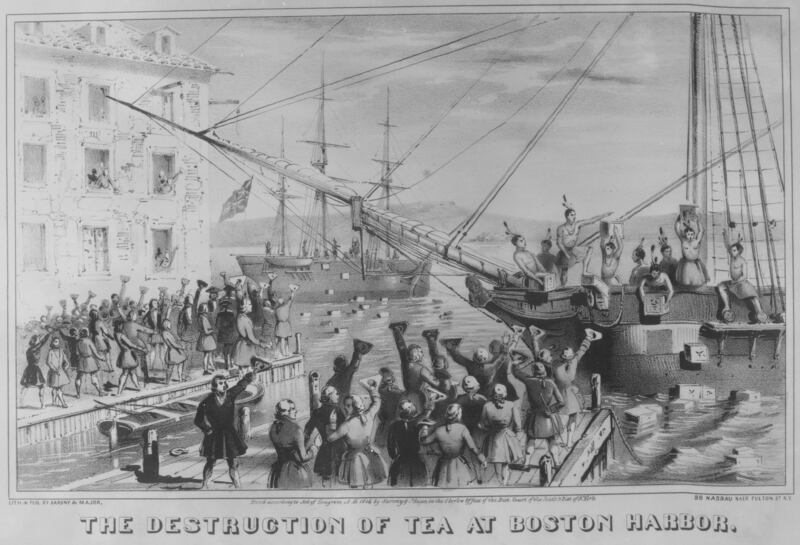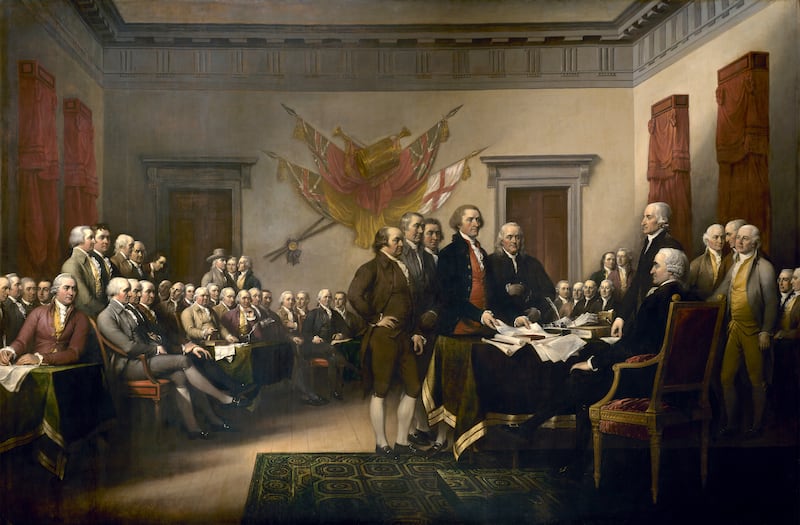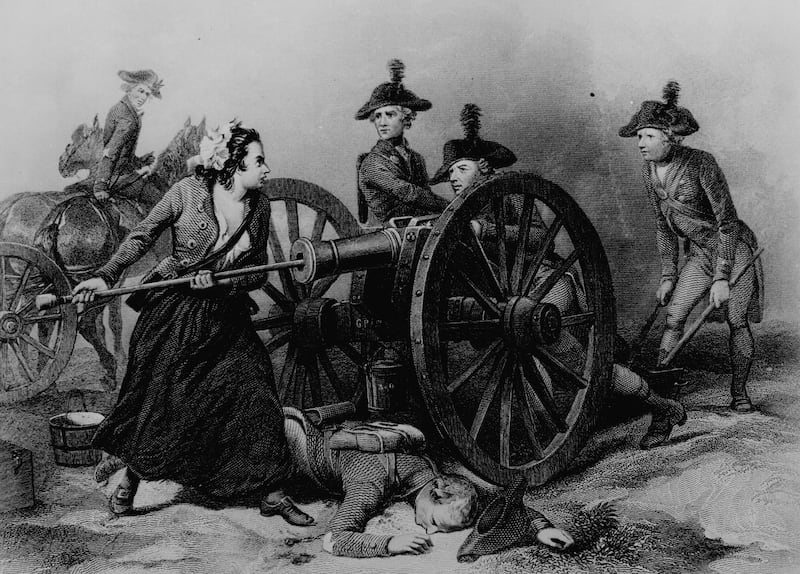Just under a decade before skirmishes in Concord and Lexington would set off the American Revolutionary War, a group known as the Daughters of Liberty formed to protest the Stamp Act, per University of Hawaii.
On April 7, 1766, an article from The Boston Chronicle said 18 Daughters of Liberty gathered at Dr. Ephraim Bowen’s house and during dinner, they “cheerfully agreed to omit tea, to render their conduct consistent. Besides this instance of their patriotism, before they separated, they unanimously resolved that the Stamp Act was unconstitutional, that they would purchase no more British manufactures unless it be repealed,” according to the University of Hawaii.
This was one of several significant events leading up the American Revolutionary War. On Tuesday, many Americans will celebrate Independence Day. It commemorates the day in 1776 when the Second Continental Congress adopted the Declaration of Independence and the colonies declared their independence.
The events precipitating the American Revolution and its aftermath were critical in shaping the United States.
Independence Day offers an opportunity to talk about this history. Whether it’s been a while since the last time you took U.S. history or you’re looking to brush up, here’s a brief history of the American Revolutionary period.
By 1750, there were four different colonies in New England: the Province of Massachusetts Bay, Rhode Island Colony, Connecticut Colony and the Province of New Hampshire. During the 1600s, European colonists sailed to the Americas and occupied these areas called the 13 original colonies. The colonies shifted and eventually merged into these four, per History of Massachusetts.
The governance of these colonies also changed. Colonies in New England started as charter colonies, which afforded them a degree of self-governance. New England colonies started shifting into royal colonies, according to History of Massachusetts. Royal governance meant the British monarchy had more direct control.
By March 22, 1765, Britain passed the Stamp Act, which was the first direct tax on the American colonies, according to the National Park Service. Colonists began organizing efforts to oppose the tax. The Sons of Liberty and the Daughters of Liberty formed.
Patrick Henry articulated an argument in May 1765 now colloquially known as “taxation without representation” and, later in the fall, the Stamp Act Congress convened in New York to discuss how the colonies would protest the Stamp Act. A lawyer by the name of James Otis said taxing without representation was disenfranchisement. He coined the phrase, “taxation without representation is tyranny,” per the Constitution Center.
After the Stamp Act Congress met, petitions were sent to the King, House of Lords and House of Commons, per Constitution Center. They were ignored. The Stamp Act was repealed the next year.
Not too much later, in October 1768, British troops arrived in the area to enforce another tax known as the Townshend Act — a tax primarily on imported goods, according to the National Park Service. King George III sent around 1,000 troops from Ireland to Boston, Massachusetts, according to Smithsonian Magazine.
On March 5, 1770, British soldiers shot and killed five colonists in Boston: Crispus Attucks, Samuel Gray, James Caldwell, Samuel Maverick and Patrick Carr, according to The Freedom Trail. This event, known as the Boston Massacre, spurred Bostonians “rallying ... against the Crown and the evacuation of troops in Boston.”
By 1772, what are known as the Committees of Correspondence formed. All the way from Nova Scotia to Georgia, these committees were established as a way to resist British policy on the colonies, according to the Mount Vernon website. Tension between the colonists and the imperialists began to rise.
In 1773, Britain passed the Tea Act which gave the British East Company a monopoly on selling tea to the colonies. Samuel Adams and the Sons of Liberty began joining with other colonists to protest this act, per Britannica.
One protest that happened is known as the Boston Tea Party. On Dec. 16, 1773, patriots dressed as Mohawk Indians dumped 342 chests of tea from the British East India Company into the Boston Harbor, per Britannica. In retaliation, Britain passed the Intolerable Acts.

The Intolerable Acts, also known as the Coercive Acts, were passed in March 1774 and required British troops to be stationed “in taverns and vacant buildings.” The port of Boston closed, per the National Park Service.
At the time, Edmund Burke said punishing the American colonies in this way would spark a “fierce spirit of liberty,” but King George III moved forward. Soon after, the American Revolutionary War would begin.
“Let it begin here,” men in Lexington said on April 19, 1775, according to the Concord Museum. It was the day the American Revolutionary War started.
“The shot heard ’round the world,” as Ralph Waldo Emerson called it, was fired at the Battle of Lexington and Concord. Colonists were standing together on Lexington Green as British troops marched forward to destroy ammunition stockpiled in Concord. It’s unknown who fired the first shot, but the war began, per University of Maryland.
Fighting ensued and skirmishes would continue between British forces and patriots. A chasm erupted in the colonies: some were still loyal to the British monarchy and known as loyalists and some fought against the monarchy and were called patriots.
It’s not exactly known how many colonists were loyalists and how many were patriots, but it’s believed there were more patriots than loyalists. “Historians have not found any connection between educational level, occupation, position in society, or economic status and the choice to be a Patriot or a Loyalist,” per Bill of Rights Institute.
After the war started, there was the Battle of Bunker Hill, the Battle of Gloucester and other significant events leading up to July 1776.
On July 4, 1776, several patriots would sign a document known as the Declaration of Independence. In part, it read, “When in the Course of human events, it becomes necessary for one people to dissolve the political bands which have connected them with another, and to assume among the powers of the earth, the separate and equal station to which the Laws of Nature and of Nature’s God entitle them, a decent respect to the opinions of mankind requires that they should declare the causes which impel them to the separation.
“We hold these truths to be self-evident, that all men are created equal, that they are endowed by their Creator with certain unalienable Rights, that among these are Life, Liberty and the pursuit of Happiness,” the Declaration of Independence said.

It would be five more years of fighting before British troops surrendered, but the Declaration of Independence marked the beginning of a sense of national unity among patriots.
Patriots were able to rally after the Declaration of Independence. Valuable information from women like Lydia Darragh led to patriots being prepared in certain situations. British officers would gather at her home and discuss plans they had. One time she overheard that the British army was planning on stealthily attacking George Washington and his troops at White March in November. According to the Boston Tea Party website, Darragh passed the information on to her son who fought in the Continental Army and Washington was able to prepare for the attack.
At the Battle of Monmouth on June 28, 1778, Mary Ludwig Hays marched with the Continental Army and fought alongside other soldiers. The legend of “Molly Pitcher” is influenced by Hays carrying water to the cannon during that battle, per the Museum of the American Revolution.
There were other key points of the war like when Washington crossed the Delaware River, the Battle of Saratoga, France’s decision to enter the war against Britain, the Battle of Cowpens and a long siege at Ninety Six by patriots, according to the National Park Service. At times, it seemed like the patriots were unlikely to win the Revolutionary War, but they soon would.
Gen. Washington led troops of patriots and French soldiers against Lord Charles Cornwallis and his British forces in a battle at Yorktown on Oct. 19, 1781. British forces surrendered and patriots won the war, per the Visit Williamsburg website.
Soon after, British troops evacuated the area and a treaty was signed — the Treaty of Paris. John Adams, Benjamin Franklin and John Jay negotiated the treaty for the patriots and the United States was recognized as an independent nation.
After the war ended, the states would live under the Articles of Confederation, but the United States wasn’t unified politically as states maintained their sovereignty. Economic problems and political divisions continued, per PBS. These problems would continue through the 19th century.
The United States would later adopt the U.S. Constitution. The Constitutional Convention convened in Philadelphia in 1787, per the White House website.
Delegates debated issues related to representation, relationships between the states, the process of amendments and other issues. There were two main groups known as the Federalists and Anti-Federalists who debated how strong the national government should be, per the National Constitution Center.
Federalists James Madison, Alexander Hamilton and John Jay published the Federalist Papers in The Independent Journal and The New York Packet under the pseudonym Publius, per the White House website. Federalists argued in favor of adopting the Constitution, which was eventually adopted and ratified by the States.
Slavery remained legal in the states and women didn’t have the right to vote. Later, abolitionists and suffragists would look back at the American Revolutionary War and be inspired by the ideals of freedom that were expressed, per U.S. History website.
America would fight another war in 1812 against Britain, a war that lasted until 1814, per Britannica. The Treaty of Ghent ended that war and then, around five decades later, the U.S. would fight the Civil War.
The American Revolution continues to influence American politics, especially the ideals expressed in the Declaration of Independence — “We hold these truths to be self-evident, that all men are created equal, that they are endowed by their Creator with certain unalienable Rights, that among these are Life, Liberty and the pursuit of Happiness.”
In addition to influencing politics, literary authors were also inspired by the American Revolution. The Romantics, known for an emphasis on individualism and freedom, looked to the French and American Revolution for inspiration, per Eastern Connecticut State University. Some of the Romantics included Percy Shelley, William Wordsworth, Lord Bryon and Sir Walter Scott. Abolitionist sentiments flourished.
Emerson, who himself was a Romantic, reflected back on the American Revolution in his Concord Hymn. He concluded, “Spirit, that made those heroes dare / To die, and leave their children free, / Bid Time and Nature gently spare / The shaft we raise to them and thee.”


